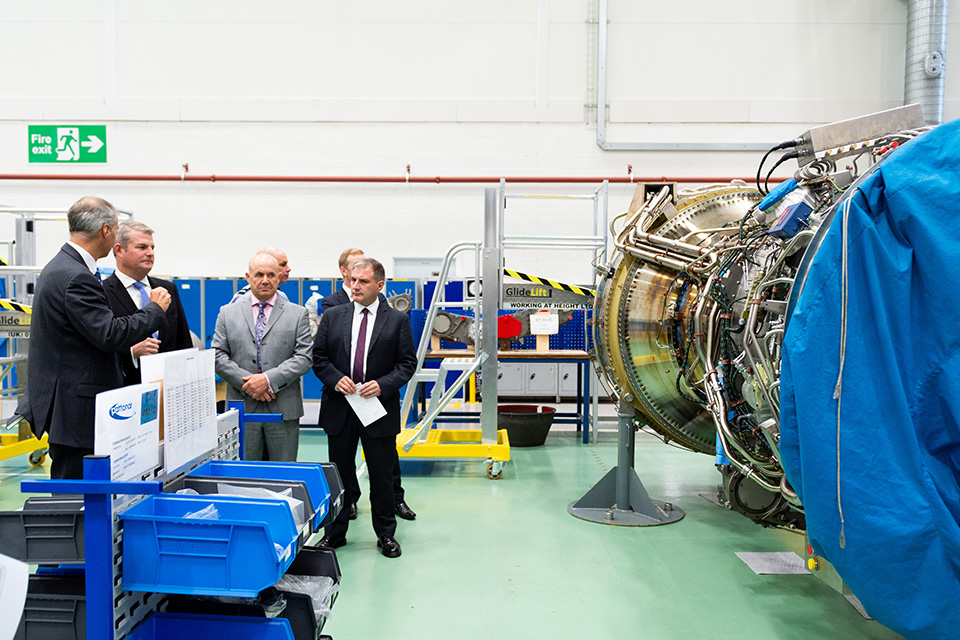Lift-off: F-35 take-off technology site opens ahead of historic flight trials
|
A state-of-the-art new facility making unique vertical lift
technology for fighter jets has been opened by Defence Minister
Stuart Andrew in Bristol today. The ‘LiftWorks’ facility, which has
opened at Rolls-Royce in Bristol, makes the ‘LiftSystem’ to provide
F-35 fighter jets with a fan propulsion system that allows them to
take off over short distances,...Request free trial
A state-of-the-art new facility making unique vertical lift technology for fighter jets has been opened by Defence Minister Stuart Andrew in Bristol today. The ‘LiftWorks’ facility, which has opened at Rolls-Royce in Bristol, makes the ‘LiftSystem’ to provide F-35 fighter jets with a fan propulsion system that allows them to take off over short distances, hover, swivel mid-air and land vertically. It is vital to the jets being able to operate from aircraft carriers, and comes ahead of the stealth jets completing their historic first trials off the flight deck of Britain’s largest ever warship, HMS Queen Elizabeth. The site will support more than 100 jobs in the area after more than £20 million was injected into transforming the former Defence Manufacturing building into an advanced facility dedicated to developing the unique technology. Defence Minister Stuart Andrew said:
The LiftSystem, which has a thrust strong enough to lift 17 Mini cars and a clutch that provides enough torque to turn the London Eye, was designed and developed by teams of engineers at Rolls Royce engineers in Bristol and Indianapolis. The Bristol site is not only making the LiftFan for UK jets, but for all F-35B jets on order across the world. Production at the site has been building up since 2009, with the official opening now marking the fact that the facility is heading towards peak manufacturing levels. British companies are building 15% by value of all 3,000 F-35s planned for production. It is projected that around £35 billion will be contributed to the UK economy through the programme, with around 25,000 British jobs also being supported. The ‘Liftworks’ facility is one of many cutting-edge manufacturing sites across the UK contributing to the wider Rolls Royce LiftSystem contract for the F35 programme. 40% of the work under this contract takes place in the UK, supporting 900 jobs across the supply chain. During the visit, the Minister unveiled a plaque marking the official opening of the Filton site before embarking on a tour of the facility where he met employees, apprentices and graduates.  Stuart
Andrew in Bristol. Crown copyright."> Stuart
Andrew in Bristol. Crown copyright.">
Chief of Materiel (Air) for the MOD’s procurement agency, Defence Equipment and Support Air Marshal Julian Young said:
Rolls-Royce Director of Customer Business Defence Alex Zino said:
The F-35B Lightning multi-role fighter jet is the first to combine radar evading stealth technology with supersonic speeds and short take-off and vertical landing capability. During his opening speech, the Minister also announced that the UK has accepted its 16th jet, which is now set to fly into Beaufort, South Carolina. There are around 200 British personnel at the American site testing the aircraft. The fighter jets will be jointly manned by the Royal Air Force and the Royal Navy and can operate from land and sea, forming a vital part of Carrier Strike when operating from the Queen Elizabeth Class aircraft carriers. It has been a monumental year for Britain’s F-35 jets, after the first aircraft touched down on home soil in RAF Marham in June, two months ahead of schedule. They are on track to be operational by the end of the year. There are now nine of the jets at the Norfolk base, whilst more British jets continue to undergo flight trials in the United States. Last month saw a British F-35 jet carry out its first trials armed with UK-built weapons, showcasing the major role that the UK plays in the supersonic aircraft. The ASRAAM missiles are built by MBDA, and the Defence Minister also paid a visit to their Bristol factory while he was in the region. The site is benefitting from contracts worth over half a billion-pounds for Royal Navy missile systems which will go on to protect the new Queen Elizabeth Class Carriers and the extended fleet from current and future threats. Both sites form a key part of defence’s huge footprint in the South West, where it spends £5.1bn with industry – more than in any other part of the country – supporting 33,500 jobs. |
